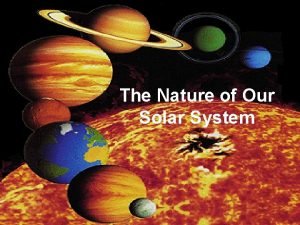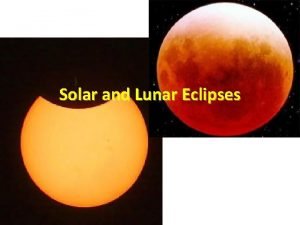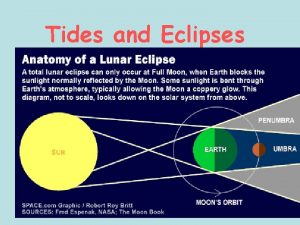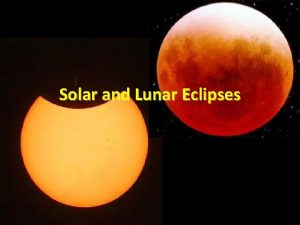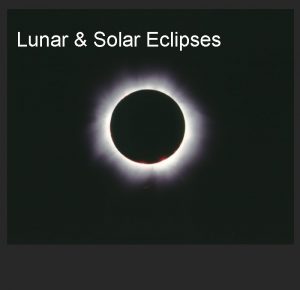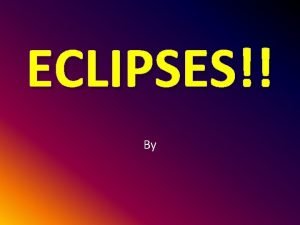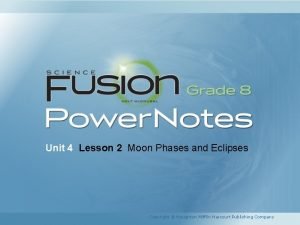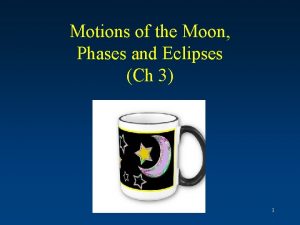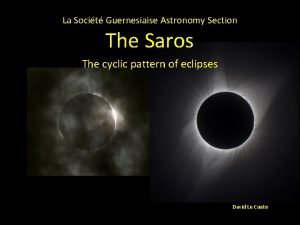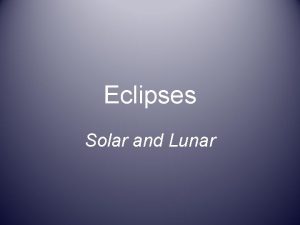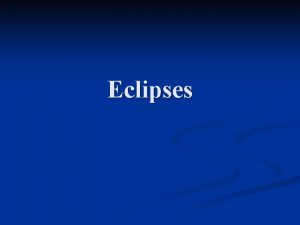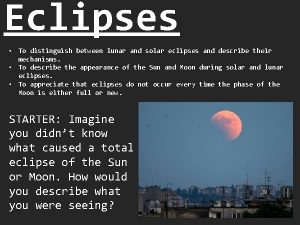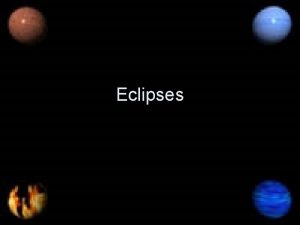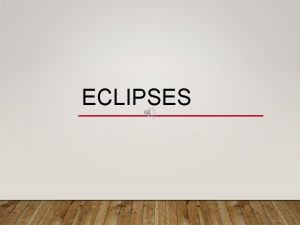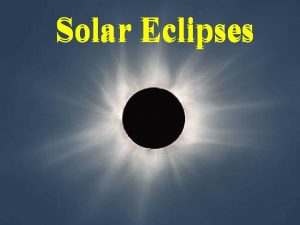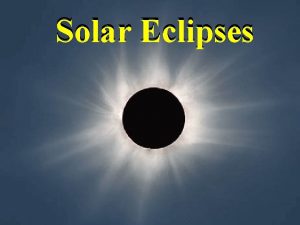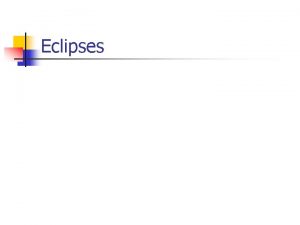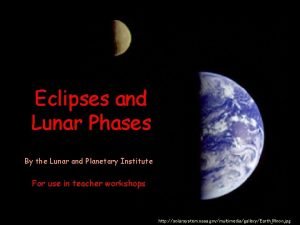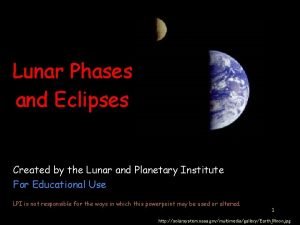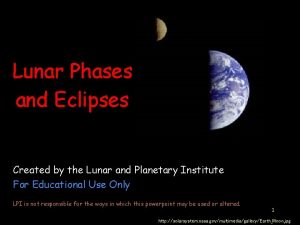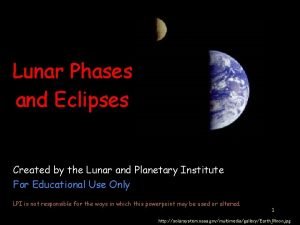Eclipses Solar and Lunar Solar and Lunar Eclipses














- Slides: 14

Eclipses Solar and Lunar

Solar and Lunar Eclipses Eclipse: The total or partial obscuring of one celestial body by another… The obscuration can be either • One celestial body blocking the view to the other: – Solar eclipse---Moon blocking Earth’s view to the Sun… • One celestial body is in the shadow of another: – Lunar eclipse---Moon is in the shadow of the Earth… Lunar eclipse image from http: //www. mreclipse. com

What Causes Eclipse? • The Earth and Moon cast shadows. • When either passes through the other’s shadow, we have an eclipse. • Because the Sun is an extended bright object, there are two different regions of the shadow: – Penumbra is partially illuminated – Umbra is completely dark Click on the image to start animation

Lunar eclipses • Lunar eclipses happen when the Moon passes through the shadow of the Earth – Everybody on the night side of Earth can see the lunar eclipse. • Lunar eclipses can be partial, penumbral, or total. • Lunar eclipses can occur only at full moon. Click on the image to start animation

Solar eclipses • Solar eclipses occur when the shadow of the Moon falls on the surface of Earth – Only people in the shadow can see the eclipse. • Solar eclipses can be partial, annular, or total. • Solar eclipses can occur only at new moon.

Eclipse Path When total or ring solar eclipses happens… • The diameter of the umbra of lunar shadow is no more than 270 km…you can see the total eclipse only if you are in a very narrow and long eclipse path. – In the 1990 total eclipse that passed through the big island of Hawaii, people on Maui and Oahu cannot see the total eclipse! • The diameter of the penumbra of the lunar shadow is about 7000 km (Earth’s diameter is about 13, 000 km). So, the region that partial eclipse can be seen is quite large…and people on Maui and Oahu could see partial eclipse! Eclipse Prediction

Total Solar Eclipse What’s the difference between a total and ring eclipse? The distance between the Earth and the Sun. You don’t see the Sun at all if you are in the umbra Sun Click on the Sun to start animation Moon You see the partial Sun if you are in the penumbra You see the whole Sun outside of the shadow Surface of the Earth

Annular Eclipse • Annular eclipse happens when the Moon does not completely block the Sun, like partial eclipses… • The umbra is NOT completely dark! • You see a ring if you are in here Sun Surface of the Earth Moon You see the partial Sun if you are in the penumbra You see the whole Sun if you are outside of the shadow

Distance Between the Moon and Earth • Like the Earth’s orbit around the Sun, the orbit of the Moon around the Earth is not a perfect circle. – Eccentricity of Earth’s orbit is ~ 0. 016 • The distance between the Moon and Earth change. This is why we have total and ring eclipses – Eccentricity of Lunar orbit is ~ 0. 05

How Often Does Eclipse Occur? • Why don’t we have one lunar and one solar eclipse a month since we have one new and one full moon each month? Click on the image to start animation

The Precession of Lunar Orbit • The orbital motion of the Moon around Earth slowly precesses with an 18. 6 year cycle as the Earth orbit the Sun… Click on the image to start animation

How Often Does Eclipse Occur? • The combination of these motions of the Moon play a part: 1. 29 ½ day orbital motion around Earth, 2. 5º tilt of the orbit with regard to the ecliptic, and 3. Precession of the lunar orbit with regard to the ecliptic, • Eclipse occurs with a period of about 18 years and 11 -1/3 days (Soras cycle)

Solar Eclipse Forecast Solar eclipses from 2004 to 2030 Knowing the orbit of the Earth and the Moon, we can now calculate the time and path of solar eclipses with great accuracy. Back to Eclipse Path

Eclipses: Summary • The parties involved: Sun, Moon, and Earth • Motion of the Moon around Earth: 1. 29 ½ day revolution of the Moon around the Sun 2. Tilt (~5º) of the lunar orbit (around the Earth) w. r. t. the Ecliptic plane (Earth’s orbital plane around the Sun) 3. The precession of the lunar orbit w. r. t. Earth-Sun direction • Solar eclipse happens when the Moon is between the Earth and the Sun. • The size and distance of the Moon need to be just right for us to see total eclipse. – – • The changing distance between the Earth and the Moon explains the occurrences of the total and ring solar eclipses. The changing distance between the Earth and the Sun, and the Earth and the Moon explains the difference in the duration of the solar eclipses. Lunar eclipse happens when Earth is between the Moon and the Sun.
 Difference between lunar and solar eclipse
Difference between lunar and solar eclipse Differentiate between lunar eclipse and solar eclipse
Differentiate between lunar eclipse and solar eclipse What type of tide occurs at a lunar and solar eclipse?
What type of tide occurs at a lunar and solar eclipse? What is an eclipse
What is an eclipse Solar lunar eclipse
Solar lunar eclipse 300 solar years to lunar years
300 solar years to lunar years Astronomy picture of the day 11 july 2001
Astronomy picture of the day 11 july 2001 Ano ang pagkakaiba ng solar at lunar eclipse
Ano ang pagkakaiba ng solar at lunar eclipse Lesson 2 moon phases and eclipses answer key
Lesson 2 moon phases and eclipses answer key Moon phases and eclipses
Moon phases and eclipses Moon phases and eclipses
Moon phases and eclipses The sun-earth-moon system worksheet answers lesson 1
The sun-earth-moon system worksheet answers lesson 1 Eclipses and tides lesson 3
Eclipses and tides lesson 3 The two eclipses
The two eclipses The two eclipses
The two eclipses
